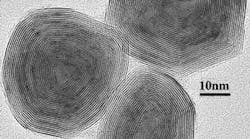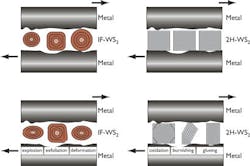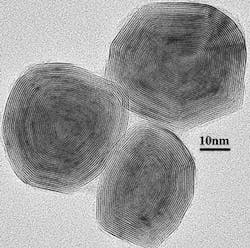Ever since the invention of the wheel, there's been a need for lubricants. In today's manufacturing environment, the need to operate machines at faster speeds and higher loads with improved efficiency and environmental friendliness has given new importance to lubricant selection. The plant manager is faced with having to decide about various lubricant options for differing demands.
Meet the dwarfOne revolutionary innovation is nanotechnology. The name comes from the Greek word nanos, meaning dwarf. Nanotechnology refers to structures about one billionth of a meter in size (one thousandth the diameter of a human hair). Nanostructures are prepared atom by atom to produce better materials with unique properties.Shrinking conventional material to the nanoscale can alter its fundamental physical and chemical properties remarkably. Nanomaterials can have unique and commercially valuable electrical, optical and mechanical properties. This opens up possibilities for applications in many fields, including manufacturing, lubrication, aerospace, automotive, biomedical, microelectronics, coatings, catalysis and energy storage.The White House Office of Science and Technology Policy has said that nanotechnology will have at least the same impact on health, wealth and security in the 21st century as the combined influence of antibiotics, the integrated circuit and polymers had in the 20th century. Nanotechnology could change the way many things are madefrom medicines to computers to machines to objects not yet imagined.Why solid lubricants?Lubricants reduce friction and wear between contacting surfaces. Oil and grease are the most common liquid lubricants. Solid lubricants, on the other hand, are preferred when liquid lubricants are impractical, such as in aerospace applications and cleanrooms, on miniature components and maintenance-free devices, in ultra-high vacuum, for intermittent or long-term storage and in high-load conditions. Solid lubricants also handle extreme temperature, pressure, radiation and reactive environments. Solid lubricants can be used either as a dry powder, a coating or an additive to fluid lubricants. Their use is steadily increasing in response to market demands for improved lubricants.Common solid lubricants are layered compoundsgraphite, molybdenum disulfide and tungsten disulfide. Molecular layers reduce friction by sliding past each other under load (see Figure 1). But layered compounds have drawbacks. The chemically reactive layer edges slowly decompose, fracture and bind to metal surfaces. The platelet's relatively large size also prevents entry into the pores of metal parts. Thus, they accumulate on the surface and stick to the machinery. These factors ultimately diminish their lubricating ability, which causes metal parts to grind against each other. Thus, there is a need for smaller, more stable solid lubricants.Figure 1. The nano-scale size, stability and spherical shape of inorganic Fullerene-like nanospheres reduce friction via an improved mechanism of rolling, rather than the sliding action of conventional layered solid lubricant additives.
Manufacturing, power generation and other industries demand stable lubricants that significantly reduce friction and wear. Factories want lubricants that help achieve high-speed, high-precision workbut don't contaminate. In the automotive industry in particular, this need is illustrated by the search for maintenance-free oil and grease. There also are substantial needs in the aerospace, tooling, drilling and semiconductor industries for better solid lubricants. Impregnated parts are valuable as self-lubricating components in large markets, such as machining, precision instruments, appliances and biomedical equipment.
Enter nanotechnologyNanotechnology-based dry lubricants feature spherical inorganic structures (see Figure 2). The structure's geometry is referred to as a Fullerene, and hence the term inorganic Fullerene-like, or IF, nanoparticles. The sphere's structure resembles Buckminster Fuller's design for geodesic domes and is thus called Fullerene in his honor.Figure 2. Transmission electron micrograph showing cross-section of inorganic Fullerene nanospheres. Note the multi-walled, onion-like structure of nested spheres.
In contrast to the flat plates of conventional solid lubricants that lubricate by sliding, inorganic Fullerene-like, nanotechnology-based solid lubricants have structures of progressively smaller concentric spheres, sometimes as many as 20 or more, nested one within the other. These act as miniature ball bearings that roll across surfaces, which provide lubrication. The nested spheres are analogous to the rings of an onion or the successively smaller figures in a Russian doll. This multi-wall structure offers many advantages. As the outer shell wears away during use, the resulting hole exposes an identical shell underneath. This automatically renewing, self-healing feature maintains lubricity. Evaluations by a number of independent laboratories indicate that inorganic Fullerene-like nanoparticles reduce friction, wear, galling, seizing and fretting better than conventional solid lubricants. The new lubricants also have been formulated as additives for oils and greases, as various types of anti-friction coatings and for impregnating self-lubricating parts.The scientific basisThe nanotechnology-based dry lubricant is based on a scientific discovery by Tenne, Margulis, Genut and Hodes working in the Nanoscience Group at the Weizmann Institute of Science in Israel. They were first to discover that certain layered inorganic compounds, such as molybdenum disulfide and tungsten disulfide, can be formed into Fullerenes. The group exploited the special conditions for inducing the layers of these materials to curve in on themselves and close into multi-walled, nano-sized particles.
Advantages for industryThe IF nanotechnology-based solid lubricant has concrete advantages for manufacturing and facility management at industrial plants. First, it reduces friction and wear about seven times better than commercial lubricants, especially at high loads (see Figure 3). It also raises the efficacy of standard oils so less oil is required for lubrication. It reduces operating costs, saves energy, extends maintenance intervals, maintains precision of machine parts and is environmentally friendly. Because friction is reduced considerably, there is a corresponding reduction in noise, vibration and heat.Figure 3. IF nanotechnology solid lubricants added to oil significantly reduces wear of metal parts. The wear in this case was measured as the depth of the wear track in the metal under identical test formulated conditions.
Used as an additive to oils and greases, IF nanotechnology-based solid lubricants address industry's demands for increased performance and environmental compliance. Every day of downtime for maintenance costs industry millions of dollars. As a result, companies prefer fill-for-life lubricants to minimize maintenance cost. The IF lubricant has been shown to maintain ultra-low friction and wear longer than conventional lubricants and is therefore suitable for such fill-for-life applications.The IF lubricant also supports minimal quantity of lubrication (MQL) specifications. The addition of the solid lubricant to machine oil reduces the required lubricant quantity without compromising its performance.Increasingly, vegetable oil-base stocks, such as sunflower and rapeseed oils, are used to replace conventional hydrocarbon lubricants. With the addition of the inorganic Fullerene-like materials, vegetable oils can achieve performance levels comparable to petroleum-based lubricants. Vegetable oils don't require special disposal and nanotechnology-based solid lubricants are environmentally safe.Takes high loadsAnother reason an inorganic Fullerene operates so well at high loads is its special structure gives it high strength. In testing, Nobel Prize Laureate Sir H. W. Kroto of the University of Sussex, England, reported that tungsten disulphide nanoparticles survive significantly more severe shock pressures (210 tons/cm2) than standard lubricants can withstand.The effect of tungsten disulfide Fullerene nanospheres on fatigue resistance of gear shafts operating under extreme pressure also was investigated. Extensive experiments completed at The TechnionIsrael Institute of Technology demonstrated that a small quantity of the lubricant added to ordinary gear oil significantly reduced friction and wear, thereby extending the life expectancy of moving parts in heavy machinery compared to conventional lubricant formulations.Until now, mating parts had to be machined to as smooth a surface as possible to provide extremely flat surfaces for friction reduction. The nanotechnology-based solid lubricant also works well on relatively rough surfaces. This means machined surfaces don't need to be tooled to a highly smooth or glossed finish, because the small particles are trapped in the crevices of the roughened surface and are released slowly during operation.A new impregnation technologyAdvances in powder metallurgy offer improved types of self-lubricating parts. Impregnating IF material into the pores of powdered metal parts improves tribological properties in comparison to that of impregnated oil or oil with conventional molybdenum disulfide or tungsten disulfide.Industries need to select the right lubricant to meet application-specific needs. When considering performance, cost-effectiveness and environmental cleanliness, a solid lubricant based on nanotechnology may be an ideal option. Dr. Menachem Genut is President and CEO of Applied NanoMaterials, Inc. He may be reached at Menachem@apnano.com.Figures: Applied NanoMaterials, Inc.


